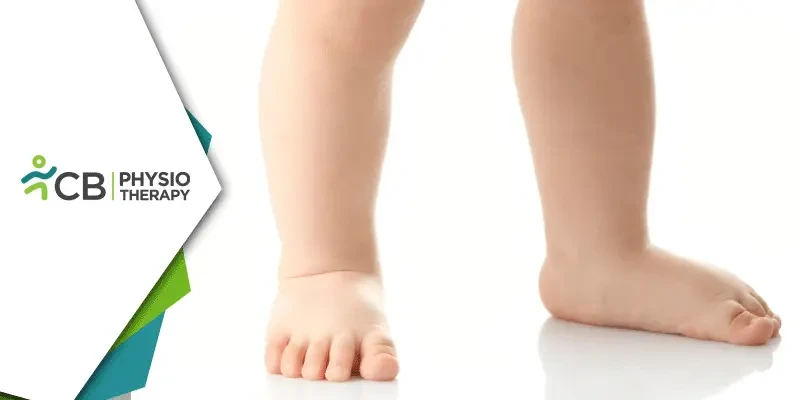Flat feet, also known as pes planus, is a condition where the arch of the foot is not fully developed, causing the entire foot to rest on the ground when standing. It is relatively common in children, especially in the early years, and while it often resolves as they grow, persistent flat feet can lead to discomfort and complications. This blog delves into the causes of flat feet in children, its potential effects, and how physiotherapy can play a vital role in helping develop and strengthen their feet for better functionality and overall health.
Understanding Flat Foot
Flat foot refers to the collapse or absence of the longitudinal arch, which runs along the inside of the foot from the heel to the ball of the foot. In babies and toddlers, this condition is typically normal because their muscles, ligaments, and bones are still developing, and the fat pads in their feet obscure the arches. However, by around the age of six, the foot arch should start becoming more defined. If this does not happen, and the arch remains flat, it may be a sign of a structural or functional issue.Flat feet can result from various factors, including children with a family history of flat feet are more likely to have the condition themselves, some children have loose ligaments or flexible joints, which may lead to flat feet as the muscles and ligaments cannot support the foot arches properly, also if the Achilles tendon is tight, it can limit the ability of the foot to move freely, contributing to flat feet.
Rarely, conditions such as cerebral palsy or muscular dystrophy can lead to flat feet, affecting the muscles’ ability to support the arches. While many children with flat feet do not experience discomfort, some may experience pain, difficulty walking, or an abnormal gait pattern, making treatment necessary.
How Flat Feet Affects a Child’s Development?
Flat feet can impact a child’s development in several ways:1: Balance and Coordination Issues: The absence of a natural arch can affect the foot’s ability to provide stability, leading to balance and coordination difficulties. These issues can make it harder for children to participate in sports or recreational activities.
2: Foot Pain and Discomfort: Some children with flat feet may experience pain in the feet, especially after prolonged standing or walking. This can also extend to other areas such as the knees, hips, and lower back due to misalignment in posture.
3: Abnormal Gait: Children with flat feet may develop an abnormal walking pattern or gait. They may overpronate (roll the foot inward excessively), which can cause wear and tear on joints and ligaments and lead to other musculoskeletal problems over time.
4: Fatigue and Muscle Strain: Since the feet act as the foundation of the body, children with flat feet may tire more easily when walking or running, as their muscles must work harder to compensate for the lack of natural arch support.
How Physiotherapy Can Help Children with Flat Feet?
Physiotherapy can be instrumental in managing flat feet in children, particularly when the condition leads to discomfort or impairs physical activity. Through targeted exercises, posture correction, and foot-strengthening techniques, physiotherapists can aid in improving the functionality of the feet. Here’s how physiotherapy helps:1. Strengthening Exercises for Foot Muscles
One of the primary goals of physiotherapy for flat feet is to strengthen the muscles that support the arch of the foot. Stronger foot muscles help maintain a more neutral foot position, reducing the stress on other parts of the foot and leg. Some exercises that physiotherapists may recommend include:
A: Towel Scrunches: The child is instructed to place their foot on a towel and use their toes to scrunch the towel toward them. This exercise helps to strengthen the intrinsic muscles of the foot that contribute to arch formation.
B: Toe Raises and Toe Spreading: These simple exercises can improve foot muscle activation, balance, and coordination by encouraging proper foot positioning during movement.
2. Stretching and Flexibility Training
Stretching the calf muscles and Achilles tendon is important for children with flat feet, particularly if tightness in these areas contributes to the condition. A physiotherapist may teach stretching techniques to lengthen the Achilles tendon and improve overall foot mobility. This allows for better movement mechanics during walking and running.
3. Posture and Gait Training
Children with flat feet often exhibit poor posture or an abnormal gait pattern, such as overpronation. Physiotherapists work with children to correct these patterns through gait analysis and retraining. This may involve teaching proper walking techniques, using visual or tactile cues to help the child adjust their foot placement, or wearing temporary orthotics to guide the foot into a more neutral position while walking.
4. Custom Orthotics and Footwear Advice
In some cases, physiotherapists may recommend the use of orthotics, which are custom-made shoe inserts that provide additional arch support. Orthotics can help alleviate pain and discomfort caused by flat feet by promoting better foot alignment. Additionally, a physiotherapist can advise parents on appropriate footwear that offers the right balance of support and flexibility for their child’s feet.
5. Balance and Coordination Exercises
Improving balance and coordination is crucial for children with flat feet to prevent injuries and improve their overall physical performance. Physiotherapists may incorporate exercises such as standing on one leg, using balance boards, or performing dynamic movements like hopping and jumping to challenge the child’s balance while strengthening the muscles of the lower limbs.
6. Monitoring and Ongoing Support
For children with persistent or more severe flat feet, regular monitoring and follow-up with a physiotherapist are essential to track their progress and make any necessary adjustments to their treatment plan. As the child grows, their condition may change, requiring modifications to their exercise regimen or the use of orthotic devices.
Early intervention can significantly improve the child’s overall foot health, reducing the risk of long-term problems while enhancing their ability to participate in physical activities with confidence.

